Cross Stitch Academy
Lanarte
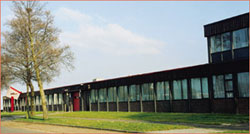
MEET LANARTE
In 1934, Augustinus (Guus) Vergnes opened a shop in Leeuwarden selling yarn and knitting wool. The range was gradually extended to include other needlecrafts, such as simple cross-stitch kits. Over the years, Guus managed to open numerous shops throughout the country under the name Naaldkunst (Needlecraft). As the offer in needlecraft kits was not very broad at that time, Guus felt the need to design his own needlecraft kits. And so he did.
This activity was given a definitive shape by the setting up of Lanarte, in the meanwhile grown into a family business. In 1973 a new business premises was built on the newly developed Schenkenschans industrial area in Leeuwarden.
MARKET LEADER IN NEEDLECRAFT KITS
Besides the collection and design of embroidery kits, yarns were imported and distributed, initially to their own Naaldkunst shops and later also to many independent Dutch retailers. The Lanarte needlecraft kits were so successful, first within and later also outside the Netherlands, that this product grew to become more and more the core business of Lanarte. And so Lanarte has been the absolute market leader in this sector for decades and Lanarte kits are highly valued all around the world. Long term relationships have been established with distributors in various countries, aided by the sales support that Lanarte offers them.
Due to the great success of the needlecraft kits and the decline in the market for knitting yarns, this subsidiary activity was halted in 1999, to allow total concentration on the core business; the manufacture and design of products for the creative consumer. Lanarte is now a specialist design and production business with distributors all over the world.LANARTE MAKES EMBROIDERY INTO ART
Many well known artists such as Willem Haenraets, Marjolein Bastin and Joadoor have made their work available to be converted into embroidery patterns. These very critical artists are, rightly, particularly demanding with regard to the conversion to cross-stitch.
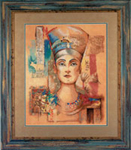
The artist Joadoor:
"I find it important that the atmosphere doesn’t disappear from my paintings. I am fascinated by warm colours; red, orange, yellow, gold. You will see them in many of my paintings. The light in Italy is one of my sources of inspiration. I used to live in Milan and in the evenings, the sun shone on the houses with a lovely yellow / orange light.
The houses are painted in pastel shades, a complete contrast with the grey, dull stone here in the city. I find it so clever that they have been able to reflect the facets of the light so well in the cross stitch design. I’m full of admiration, ‘Lanarte makes embroidery into art."
The collection of embroidery kits from Maria van Scharrenburg, a well known embroidery artist, was taken over by Lanarte in 2001, adding a complete collection to the range.
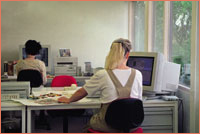
IN-HOUSE STUDIO
The paintings are converted into cross-stitch patterns using a software package developed in-house. Determining the colours and nuances remains a job for (specialist) people. The creative studio is continually busy looking for new ways. For example, a screen printed background gives an extra dimension to a piece of embroidery and different embroidery fabrics are used for the various designs.
Thanks to the special relationship between Lanarte and its customers, they have a good view of what consumers want. To gauge trends, extended training takes place in international exchanges. The knowledge of how to translate this into qualitatively outstanding products has made Lanarte into the market leader in cross-stitch kits.
That is how Lanarte has developed into a dynamic customer and consumer oriented company, continually on the hunt for new challenges.
THE ART STUDIO
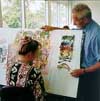
The unique character of each Lanarte cross-stitch kit is a result of a specialized design technique, developed in the Lanarte design studio in Holland. The designer's first concern is to procure artwork that complements the decor of the modern home. To this end, designers diligently study current decorating trends, attend international conventions, and subscribe to current professional decorating periodicals. Many designs are derived from drawings or paintings created by well-known professional artists. After gathering drawings and painting from all over the world, a team of specialists in the Lanarte studio determines which designs are artistically appropriate for the Lanarte collection, and suitable for translation into cross-stitch.
Following this careful selection of artwork, the real work begins. First the design team meets to determine the execution of the design. A drawing may need to be simplified or may be more beautiful when just a portion of the drawing is used. Then the finished size of the project is determined. The colours are chosen based on current decorating trends, and years of decorating experience. For example, blue, yellow and terracotta tints may be used to reflect current styles. The use of the correct colour is essential, as it will ultimately determine the overall character of the finished work. Finally the design team decides whether the embroidered needs the addition of an embroidered frame-line. The final fabric choice can now be made.
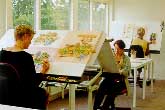
When all aspects of the design process are complete, one member of the team will create a mosaic drawing. Translation from drawing to embroidery is a special skill requiring accurate drawing skill and an eye for colours. It requires extensive company training over a long period of time. The translation to embroidery is computer assisted. As standard computer software does not meet our high standards a bespoke package was developed especially for Lanarte. Although translation has been done by computer in recent years, the personal touch of the experienced designer gives the finished product a uniquely "Lanarte" quality. The computer is only a tool; the designer dictates what the com-puter should do. After the mosaic drawing is completed and approved, the first embroidery is made. The finished product is analyzed, minute details are studied, and corrections will be made. The overall picture must reflect the style of the original artist. After the mosaic drawing is corrected and everyone is satisfied, the final embroidery is made. The completed embroidery must then be finished off, and suitably framed.
The frame is chosen carefully from the Lanarte collection to enhance the look of the embroidery. The framed embroidery now goes to the photographer, and a photograph for the front cover of the kit is taken. Meanwhile other members of the design team determine the correct amount of floss. Instructions are carefully written and then translated into 8 languages (English, Dutch, French, German, Spanish, Italian, Swedish and Russian) for export around the world. When all of this is finished, the embroidery is ready for production. The kits are carefully assembled, inspected and packaged. In the production department as in all departments at Lanarte, the slogan is
QUALITY FIRST!
Sourсe: http://www.lanarte.com/


